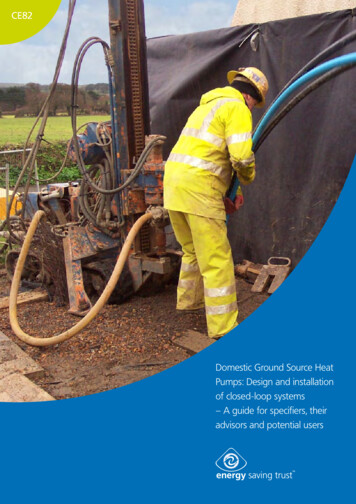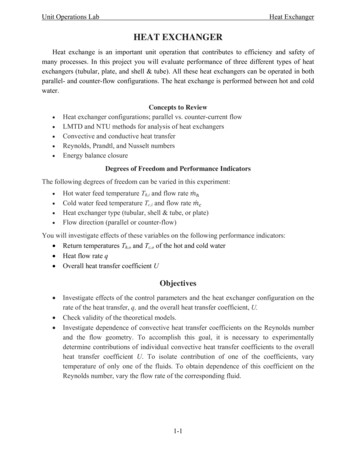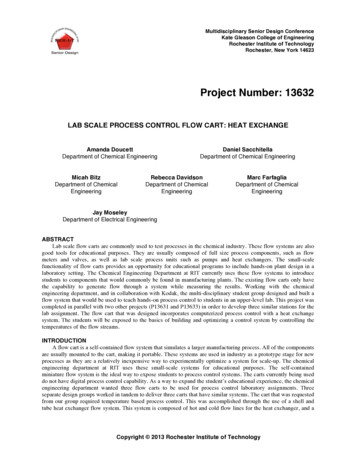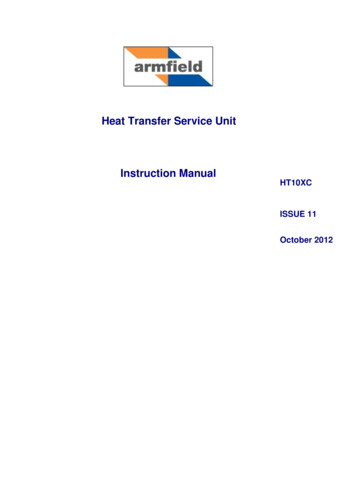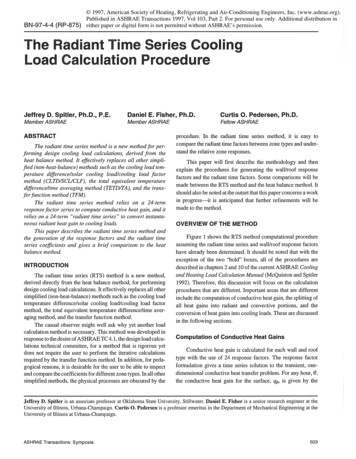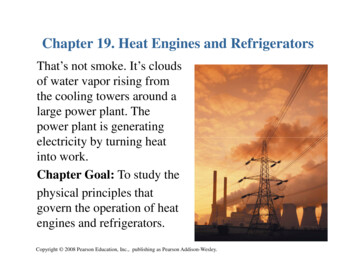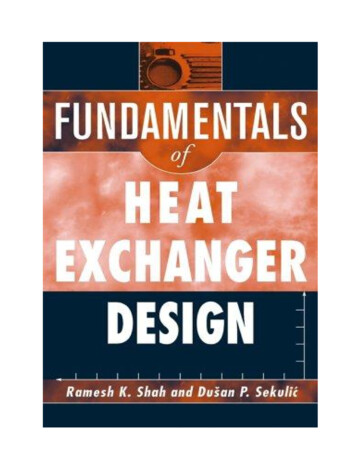
Transcription
FUNDAMENTALS OF HEATEXCHANGER DESIGNFundamentals of Heat Exchanger Design. Ramesh K. Shah and Dušan P. SekulicCopyright 2003 John Wiley & Sons, Inc.
FUNDAMENTALS OFHEAT EXCHANGERDESIGNRamesh K. ShahRochester Institute of Technology, Rochester, New YorkFormerly at Delphi Harrison Thermal Systems, Lockport, New YorkDušan P. SekulićUniversity of Kentucky, Lexington, KentuckyJOHN WILEY & SONS, INC.
1This book is printed on acid-free paper. *Copyright # 2003 by John Wiley & Sons, Inc. All rights reservedPublished by John Wiley & Sons, Inc., Hoboken, New JerseyPublished simultaneously in CanadaNo part of this publication may be reproduced, stored in a retrieval system, or transmitted in anyform or by any means, electronic, mechanical, photocopying, recording, scanning, or otherwise,except as permitted under Section 107 or 108 of the 1976 United States Copyright Act, without eitherthe prior written permission of the Publisher, or authorization through payment of the appropriateper-copy fee to the Copyright Clearance Center, Inc., 222 Rosewood Drive, Danvers, MA 01923,(978) 750-8400, fax (978) 750-4470, or on the web at www.copyright.com. Requests to the Publisherfor permission should be addressed to the Permissions Department, John Wiley & Sons, Inc.,111 River Street, Hoboken, NJ 07030, (201) 748-6011, fax (201) 748-6008,e-mail: permcoordinator@wiley.com.Limit of Liability/Disclaimer of Warranty: While the publisher and author have used their bestefforts in preparing this book, they make no representations or warranties with respect to theaccuracy or completeness of the contents of this book and specifically disclaim any impliedwarranties of merchantability or fitness for a particular purpose. No warranty may be created orextended by sales representatives or written sales materials. The advice and strategies containedherein may not be suitable for your situation. You should consult with a professional whereappropriate. Neither the publisher nor author shall be liable for any loss of profit or any othercommercial damages, including but not limited to special, incidental, consequential, or otherdamages.For general information on our other products and services or for technical support, please contactour Customer Care Department within the United States at (800) 762-2974, outside the UnitedStates at (317) 572-3993 or fax (317) 572-4002.Wiley also publishes its books in a variety of electronic formats. Some content that appears in printmay not be available in electronic books. For more information about Wiley products, visit our website at www.wiley.comLibrary of Congress Cataloging-in-Publication Data:Shah, R. K.Fundamentals of heat exchanger design / Ramesh K. Shah, Dušan P. Sekulić.p. cm.Includes index.ISBN 0-471-32171-01. Heat exchangers–Design and construction. I. Sekulić, Dušan P. II. Title.TJ263 .S42 2003621.402 0 5–dc212002010161Printed in the United States of America10 9 8 7 6 5 4 3 2 1
ContentsPrefacexvNomenclaturexix1Classification of Heat Exchangers1.1 Introduction111.2Classification According to Transfer Processes1.2.1 Indirect-Contact Heat Exchangers1.2.2 Direct-Contact Heat Exchangers3371.3Classification According to Number of Fluids81.4Classification According to Surface Compactness1.4.11.4.21.51.61.72Gas-to-Fluid ExchangersLiquid-to-Liquid and Phase-Change Exchangers81112Classification According to Construction Features121.5.11.5.21.5.31.5.413223647Tubular Heat ExchangersPlate-Type Heat ExchangersExtended Surface Heat ExchangersRegeneratorsClassification According to Flow Arrangements561.6.11.6.25764Single-Pass ExchangersMultipass ExchangersClassification According to Heat Transfer Mechanisms73SummaryReferencesReview Questions737374Overview of Heat Exchanger Design Methodology782.1Heat Exchanger Design 838790929393Process and Design SpecificationsThermal and Hydraulic DesignMechanical DesignManufacturing Considerations and Cost EstimatesTrade-off FactorsOptimum DesignOther Considerations
viCONTENTS2.23Interactions Among Design ConsiderationsSummaryReferencesReview QuestionsProblemsBasic Thermal Design Theory for .41001021041073.9Heat Exchanger Effectiveness "Heat Capacity Rate Ratio C*Number of Transfer Units NTU114114118119Effectiveness – Number of Transfer Unit Relationships1213.4.1122Single-Pass ExchangersThe P-NTU re Effectiveness PNumber of Transfer Units, NTUHeat Capacity Rate Ratio RGeneral P–NTU Functional RelationshipP–NTU Relationships3.6.23.8Assumptions for Heat Transfer AnalysisProblem FormulationBasic DefinitionsThermal Circuit and UAThe "-NTU Method3.6.13.797Formal Analogy between Thermal and Electrical EntitiesHeat Exchanger Variables and Thermal Circuit3.3.13.3.23.3.33.49394949595Parallel Counterflow Exchanger, Shell Fluid Mixed, 1–2TEMA E ShellMultipass Exchangers142142164The Mean Temperature Difference Method1863.7.13.7.2186187Log-Mean Temperature Difference, LMTDLog-Mean Temperature Difference Correction Factor FF Factors for Various Flow Arrangements1903.8.13.8.23.8.33.8.4Counterflow ExchangerParallelflow ExchangerOther Basic Flow ArrangementsHeat Exchanger Arrays and Multipassing190191192201Comparison of the "-NTU, P–NTU, and MTD s to the Sizing and Rating ProblemsThe "-NTU MethodThe P-NTU MethodThe MTD Method3.10 The -P and P1 P2 Methods3.10.1 The -P Method3.10.2 The P1 P2 Method210210211
CONTENTS3.11 Solution Methods for Determining Exchanger 3.11.7Exact Analytical MethodsApproximate MethodsNumerical MethodsMatrix FormalismChain Rule MethodologyFlow-Reversal SymmetryRules for the Determination of Exchanger Effectivenesswith One Fluid Mixed3.12 Heat Exchanger Design ProblemsSummaryReferencesReview 9220227Additional Considerations for Thermal Design of Recuperators2324.1Longitudinal Wall Heat Conduction Effects4.1.1 Exchangers with C* ¼ 04.1.2 Single-Pass Counterflow Exchanger4.1.3 Single-Pass Parallelflow Exchanger4.1.4 Single-Pass Unmixed–Unmixed Crossflow Exchanger4.1.5 Other Single-Pass Exchangers4.1.6 Multipass Exchangers232Nonuniform Overall Heat Transfer iiTemperature EffectLength EffectCombined Effect236236239239239239Additional Considerations for Extended Surface Exchangers2584.3.14.3.24.3.34.3.4259272288289Thin Fin AnalysisFin EfficiencyFin EffectivenessExtended Surface EfficiencyAdditional Considerations for Shell-and-Tube Exchangers2914.4.1 Shell Fluid Bypassing and Leakage4.4.2 Unequal Heat Transfer Area in Individual Exchanger Passes4.4.3 Finite Number of BafflesSummaryReferencesReview QuestionsProblems291296297298298299302Thermal Design Theory for Regenerators3085.1Heat Transfer Analysis3085.1.15.1.25.1.3308310312Assumptions for Regenerator Heat Transfer AnalysisDefinitions and Description of Important ParametersGoverning Equations
viiiCONTENTS5.25.3The "-NTUo Method5.2.1 Dimensionless Groups5.2.2 Influence of Core Rotation and Valve Switching Frequency5.2.3 Convection Conductance Ratio (hA)*5.2.4 "-NTUo Results for a Counterflow Regenerator5.2.5 "-NTUo Results for a Parallelflow Regenerator316316320320321326The – Method3375.3.15.3.25.3.33413443455.4Influence of Longitudinal Wall Heat Conduction3485.5Influence of Transverse Wall Heat Conduction3555.5.13555.65.7Simplified TheoryInfluence of Pressure and Carryover Leakages5.6.16Comparison of the "-NTUo and – MethodsSolutions for a Counterflow RegeneratorSolution for a Parallelflow RegeneratorModeling of Pressure and Carryover Leakages for a RotaryRegeneratorInfluence of Matrix Material, Size, and ArrangementSummaryReferencesReview QuestionsProblems360360366371372373376Heat Exchanger Pressure Drop 783803803816.26.36.46.56.66.7Importance of Pressure DropFluid Pumping DevicesMajor Contributions to the Heat Exchanger Pressure DropAssumptions for Pressure Drop AnalysisExtended Surface Heat Exchanger Pressure Drop3816.2.16.2.2382391Plate-Fin Heat ExchangersTube-Fin Heat ExchangersRegenerator Pressure DropTubular Heat Exchanger Pressure Drop3923936.4.16.4.2393393Tube BanksShell-and-Tube ExchangersPlate Heat Exchanger Pressure DropPressure Drop Associated with Fluid Distribution Elements3973996.6.16.6.26.6.3399399403Pipe LossesSudden Expansion and Contraction LossesBend LossesPressure Drop Presentation4126.7.16.7.2413414Nondimensional Presentation of Pressure Drop DataDimensional Presentation of Pressure Drop Data
CONTENTS6.87ixPressure Drop Dependence on Geometry and Fluid Properties418SummaryReferencesReview QuestionsProblems419420420422Surface Basic Heat Transfer and Flow Friction Characteristics4257.1Basic .47.57.6Dimensionless Groups4417.2.17.2.27.2.3Fluid FlowHeat TransferDimensionless Surface Characteristics as a Function of theReynolds Number443446Experimental Techniques for Determining Surface 7.8Steady-State Kays and London TechniqueWilson Plot TechniqueTransient Test TechniquesFriction Factor Determination449Analytical and Semiempirical Heat Transfer and Friction FactorCorrelations for Simple 02507508510Fully Developed FlowsHydrodynamically Developing FlowsThermally Developing FlowsSimultaneously Developing FlowsExtended Reynolds AnalogyLimitations of j vs. Re PlotExperimental Heat Transfer and Friction Factor Correlations forComplex 523Tube BundlesPlate Heat Exchanger SurfacesPlate-Fin Extended SurfacesTube-Fin Extended SurfacesRegenerator SurfacesInfluence of Temperature-Dependent Fluid Properties7.6.17.7Boundary LayersTypes of FlowsFree and Forced ConvectionBasic DefinitionsCorrection Schemes for Temperature-Dependent FluidProperties529530Influence of Superimposed Free Convection5327.7.17.7.2533535Horizontal Circular TubesVertical Circular TubesInfluence of Superimposed Radiation5377.8.1538Liquids as Participating Media
xCONTENTS7.8.2 Gases as Participating MediaSummaryReferencesReview QuestionsProblems8Heat Exchanger Surface Geometrical Characteristics5638.1Tubular Heat Exchangers5638.1.18.1.25635668.28.3Inline ArrangementStaggered ArrangementTube-Fin Heat Exchangers5698.2.18.2.28.2.3569572574Circular Fins on Circular TubesPlain Flat Fins on Circular TubesGeneral Geometric Relationships for Tube-Fin ExchangersPlate-Fin Heat Exchangers5748.3.18.3.28.3.3574580584Offset Strip Fin ExchangerCorrugated Louver Fin ExchangerGeneral Geometric Relationships for Plate-Fin Surfaces8.4Regenerators with Continuous Cylindrical Passages5858.4.15858.5Shell-and-Tube Exchangers with Segmental 553Triangular Passage RegeneratorTube CountWindow and Crossflow Section GeometryBypass and Leakage Flow AreasGasketed Plate Heat ExchangersSummaryReferencesReview Questions597598598599Heat Exchanger Design Procedures6019.1601Fluid Mean Temperatures9.1.19.1.29.1.39.29.39.4Heat Exchangers with C * 0Counterflow and Crossflow Heat ExchangersMultipass Heat Exchangers603604604Plate-Fin Heat Exchangers6059.2.19.2.2605617Rating ProblemSizing ProblemTube-Fin Heat ce GeometriesHeat Transfer CalculationsPressure Drop CalculationsCore Mass Velocity EquationPlate Heat Exchangers6329.4.19.4.2633635Limiting Cases for the DesignUniqueness of a PHE for Rating and Sizing
CONTENTS9.4.39.4.49.59.6Rating a PHESizing a PHExi637645Shell-and-Tube Heat Exchangers6469.5.19.5.29.5.39.5.4646650658663Heat Transfer and Pressure Drop CalculationsRating ProcedureApproximate Design MethodMore Rigorous Thermal Design MethodHeat Exchanger Optimization664SummaryReferencesReview QuestionsProblems66766766866910 Selection of Heat Exchangers and Their Components10.1 Selection Criteria Based on Operating ating Pressures and TemperaturesCostFouling and CleanabilityFluid Leakage and ContaminationFluids and Material CompatibilityFluid Type10.2 General Selection Guidelines for Major Exchanger Types10.2.110.2.210.2.310.2.4Shell-and-Tube ExchangersPlate Heat ExchangersExtended-Surface ExchangersRegenerator Surfaces10.3 Some Quantitative Considerations10.3.1 Screening Methods10.3.2 Performance Evaluation Criteria10.3.3 Evaluation Criteria Based on the Second Law ofThermodynamics10.3.4 Selection Criterion Based on Cost EvaluationSummaryReferencesReview QuestionsProblems11 Thermodynamic Modeling and Analysis11.1 Introduction11.1.1 Heat Exchanger as a Part of a System11.1.2 Heat Exchanger as a Component11.2 Modeling a Heat Exchanger Based on the First Law ofThermodynamics11.2.1 Temperature Distributions in Counterflow and ParallelflowExchangers11.2.2 True Meaning of the Heat Exchanger 5
xiiCONTENTS11.2.3 Temperature Difference Distributions for Parallelflow andCounterflow Exchangers11.2.4 Temperature Distributions in Crossflow Exchangers11.3 Irreversibilities in Heat Exchangers11.3.1 Entropy Generation Caused by Finite Temperature Differences11.3.2 Entropy Generation Associated with Fluid Mixing11.3.3 Entropy Generation Caused by Fluid Friction11.4 Thermodynamic Irreversibility and Temperature Cross Phenomena11.4.1 Maximum Entropy Generation11.4.2 External Temperature Cross and Fluid Mixing Analogy11.4.3 Thermodynamic Analysis for 1–2 TEMA J Shell-and-TubeHeat Exchanger74874975575675976276376376576611.5 A Heuristic Approach to an Assessment of Heat ExchangerEffectiveness77111.6 Energy, Exergy, and Cost Balances in the Analysis and Optimizationof Heat ture–Enthalpy Rate Change DiagramAnalysis Based on an Energy Rate BalanceAnalysis Ba
6 Heat Exchanger Pressure Drop Analysis 378 6.1 Introduction 378 6.1.1 Importance of Pressure Drop 378 6.1.2 Fluid Pumping Devices 380 6.1.3 Major Contributions to the Heat Exchanger Pressure Drop 380 6.1.4 Assumptions for Pressure Drop Analysis 381 6.2 Extended Surface Heat Exchanger Pressure Drop 381 6.2.1 Plate-Fin Heat Exchangers 382

